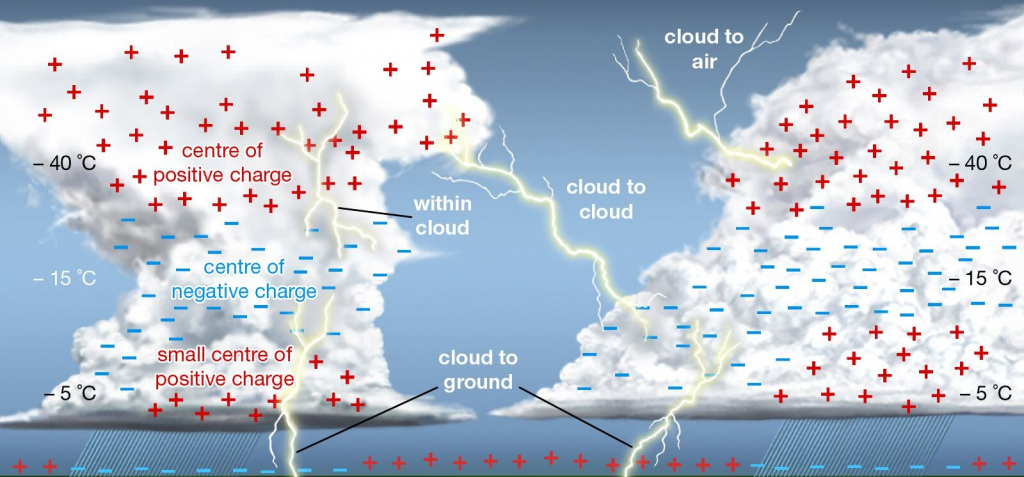Context:
Nearly 68 were reportedly struck dead by lightning on a single day in Uttar Pradesh, Rajasthan and Madhya Pradesh, according to reports from States in July 2021.
Relevance:
GS-III: Disaster Management, GS-I: Geography (Climatology, Important Geophysical Phenomenon)
Dimensions of the Article:
- What is Lightning?
- More about Clouds that generate lightning and how they are formed
- What happens when lightning strikes Earth’s Surface?
- About Lightning Strikes in India
What is Lightning?
- Lightning is a natural ‘electrical discharge of very short duration and high voltage between a cloud and the ground or within a cloud’, accompanied by a bright flash and sound, and sometimes thunderstorms.
- In simple words, it is a very rapid and massive discharge of electricity in the atmosphere.
- It happens as a result of the difference in electrical charge between the top and bottom of a cloud, or between 2 clouds or between clouds and the ground.
- Inter cloud or intra cloud (IC) lightning are visible and harmless.
- Cloud to ground (CG) lightning is harmful as the ‘high electric voltage and electric current’ leads to electrocution.

More about Clouds that generate lightning and how they are formed
- The lightning-generating clouds are typically about 10-12 km in height, with their base about 1-2 km from the Earth’s surface. The temperatures at the top range from -35°C to -45°C.
- As water vapour moves upwards in the cloud, it condenses into water due to decreasing temperatures. A huge amount of heat is generated in the process, pushing the water molecules further up.
- As they move to temperatures below zero, droplets change into small ice crystals. As they continue upwards, they gather mass, until they become so heavy that they start descending.
- It leads to a system where smaller ice crystals move upwards while larger ones come down. The resulting collisions trigger release of electrons, in a process very similar to the generation of electric sparks. The moving free electrons cause more collisions and more electrons leading to a chain reaction.
- The process results in a situation in which the top layer of the cloud gets positively charged while the middle layer is negatively charged.
- In little time, a huge current, of the order of lakhs to millions of amperes, starts to flow between the layers.
What happens when lightning strikes Earth’s Surface?
- The Earth is a good conductor of electricity. While electrically neutral, it is relatively positively charged compared to the middle layer of the cloud. As a result, an estimated 20-25% of the current flow is directed towards the Earth. It is this current flow that results in damage to life and property.
- Lightning has a greater probability of striking raised objects on the ground, such as trees or buildings.
- Lightning Conductor is a device used to protect buildings from the effect of lightning. A metallic rod, taller than the building, is installed in the walls of the building during its construction.
- The most lightning activity on Earth is seen on the shore of Lake Maracaibo in Venezuela.
About Lightning Strikes in India
- The Home Ministry’s statistics consistently cited lightning as the biggest natural disaster-linked killer in India.
- Several thousand thunderstorms occur over India every year. Each can involve several — sometimes more than a hundred — lightning strikes.
- Occurrences of lightning are not tracked in India. There is simply not enough data for scientists to work with.
- Lightning is the biggest contributor to accidental deaths due to natural causes.
- In 2019, an analysis by Skymet reported that five States accounted for half the lightning strikes that year, led by Odisha with 9,37,462 strikes or about 16% of the cloud-to-ground strikes. There were 20 million lightning strikes in that period with over 72% of them being instances of “in-cloud” lightning.
-Source: The Hindu



